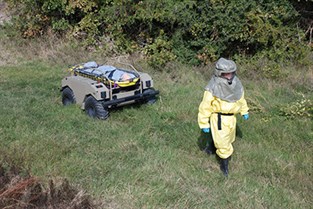Nov 20 2014
The Center for Robotic-Assisted Search and Rescue (CRASAR), with funding from the Center for Emergency Informatics, and the TEEX Product Development Center, held two days of robotics workshops specifically geared towards medical disasters.

The first day’s activities were hosted by CRASAR and held at the National Center for Therapeutic Manufacturing. The day was separated into two portions. The first was a simulcast of shared presentations with the other three sites and brainstorming as part of the planning workshops on Safety Robotics for Ebola Workers for the White House OSTP/National Robotic Initiative.
The Texas A&M Workshop on Robotic, Automation and Cyber Physical Systems for Medical Response to Disasters was held during the second portion of the day and provided additional discussions and brainstorming on general domestic medical response. These covered the state of the practice in DoD robots (TARDEC) and casualty evacuation systems (TATRC) that can be repurposed, lessons learned so far in using robots at the Fukushima Daiichi decommissioning (University of Tokyo), and opportunities for community recovery (TAMU Hazards Reduction and Recovery Center). The day concluded with a reception and a keynote talk by Andrew Natsios, from the TAMU Bush School of Government and Public Policy, who served as administrator of USAID for several years.
The Infectious Disease Response Workshop, hosted by Caleb Holt and the TEEX Product Development Center, took part on the second day and was held at the TEEX Emergency Operations Training Center/Disaster City® complex. Various aspects of medical response was the emphasis of the day, and is included in many of the TEEX courses taught.
A major portion of the day was spent demonstrating the current practices in medical response by walking participants through various scenarios including a field hospital and showing how contaminated waste is stored and over-packed and how first responders, equipment, and vehicles are decontaminated.
“The major takeaway was that robots do exist that could be immediately repurposed now to protect Ebola health workers but how robots fit into the medical response enterprise is as important as what the robots can actually do,”said CRASAR Director and Raytheon Professor, Dr. Robin Murphy.
Researchers from different sites joined in on the event. Liaison to White House Office of Science and Technology Policy and former Dean of School of Computer Science at Carnegie Mellon University Randy Bryant, NSF CISE Directorate Program Manager and former CSE faculty Jeff Trinkle, and NSF CISE Directorate Program Manager Greg Chirikijian, participated at the Washington D.C. site.
The two other sites besides Texas A&M the National Science Foundation which attracted agencies, University of California Berkeley which focused on clinical uses of robots, and the Worchester Polytechnic Institute which engaged Boston area robotics firms. "It was an honor to be one of the four sites hosting a workshop with the White House Office of Science, Technology, and Policy and it is another example of how Texas A&M is a leader in emergency informatics and field robotics,” Murphy said.